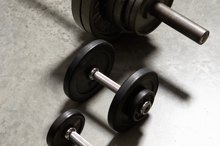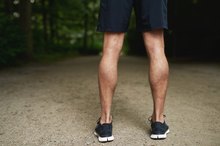Symptoms of a Torn Calf Muscle
Your calf muscle is referred to as a single muscle, but it is actually two separate muscles: the gastrocnemius and the soleus. When one or both of these muscles are overstretched, the muscle fibers can tear, resulting in various symptoms, including pain and swelling. The severity of the symptoms and the course of treatment depend on the extensiveness of the tear.
If you are experiencing serious medical symptoms, seek emergency treatment immediately.
Tips
Symptoms of a torn calf muscle include pain, swelling, bruising and weakness or loss of function.
Symptoms Based on Severity
A muscle strain refers to the stretching or tearing of muscle fibers. Muscle strains are categorized based on the extent of the damage and the symptoms you might experience 2.
A grade I strain is mild. Only a few muscle fibers are overstretched or torn. There may be mild pain and swelling, but the muscle is otherwise in good condition with no loss of strength or function. With a grade I strain, you shouldn't have any trouble walking around and completing daily activities.
A grade II strain is a moderate injury. More muscle fibers are affected and the pain and swelling are more severe. There may be some bruising as well as muscle weakness. With a grade II strain, walking may be painful and some activities may be limited.
A grade III strain is the most serious, resulting in a complete tear. This may be accompanied by a popping sound or sensation at the time of injury. This occurs as the muscle separates in two or as it rips away from the tendon that attaches it to bone.
- A muscle strain refers to the stretching or tearing of muscle fibers.
- There may be mild pain and swelling, but the muscle is otherwise in good condition with no loss of strength or function.
How Does It Feel?
Torn Tendons & Ligaments From Hyperextension
Learn More
A calf muscle with a grade III strain will be quite painful, swollen and discolored. You may see a gap or dent where the muscle is torn. As this type of severe calf muscle tear results in complete loss of function, performing any activity will be challenging if not impossible.
The symptoms don't really explain how a torn calf muscle feels. Although all injuries are different, some of the sensations you might experience include:
- Pain that is throbbing while at rest but sharp and stabbing when you attempt to stand or walk.
- Sharp pain when you move or stretch the ankle or knee.
- Spasms, or sudden involuntary contractions, of the calf muscle.
Read more: What Are the Treatments for Calf Muscle Pain?
- A calf muscle with a grade III strain will be quite painful, swollen and discolored.
- Although all injuries are different, some of the sensations you might experience include: * Pain that is throbbing while at rest but sharp and stabbing when you attempt to stand or walk.
* Sharp pain when you move or stretch the ankle or knee.
* Spasms, or sudden involuntary contractions, of the calf muscle.
Read more: What Are the Treatments for Calf Muscle Pain?
Getting the Right Treatment
Typically a torn calf muscle refers to a complete tear, rather than just a muscle strain. In this case, it's important to seek medical attention as soon as possible. Especially if you heard or felt a pop at the time of injury, you should call your doctor right away.
Your doctor will want to know what you were doing when you were injured. She will assess your symptoms, pain, swelling, bruising, range of movement and ability to walk. If you visit her office, she may ask you to perform some physical tests to assess the degree of the tear and muscle function. If your doctor is still unsure of the extent of the injury, she may order more tests, including X-rays and magnetic image resonance (MRI).
With a complete tear, your doctor will likely refer you to an orthopedic specialist for further treatment. Treatment for torn muscles typically includes immobilization or surgery followed by physical therapy.
- Typically a torn calf muscle refers to a complete tear, rather than just a muscle strain.
- If your doctor is still unsure of the extent of the injury, she may order more tests, including X-rays and magnetic image resonance (MRI).
Treatment for Less Severe Injuries
The Pain in My Right Calf Hurts More When I Squat
Learn More
If the tear is not complete, your doctor will send you home with instructions for self-care using the RICE treatment protocol. This method involves:
- Rest. Refrain from exercise, sports or other strenuous activities and rest the leg as much as possible.
- Ice. Apply ice to the calf muscle for 10 to 20 minutes at a time once every hour or as often as possible.
- Compression. Wrap the lower leg in an elastic bandage to reduce swelling and provide support for weakened muscles.
- Elevation. Elevate the leg at or above the level of the heart to draw fluid away from the injury site.
RICE is most effective when initiated immediately after the injury and continued for at least 48 hours. Even if you have not spoken to your doctor yet, you can begin RICE until your doctor gives you further instructions.
Your doctor may also recommend that you use over-the-counter pain relievers, such as acetaminophen or ibuprofen, to help reduce pain and swelling.
- If the tear is not complete, your doctor will send you home with instructions for self-care using the RICE treatment protocol.
- Wrap the lower leg in an elastic bandage to reduce swelling and provide support for weakened muscles. * Elevation.
Recovery of a Torn Calf Muscle
Your recovery will depend on your individual injury. According to Harvard Health Publishing, mild muscle strains will heal within a few weeks 2. Grade II tears can take two to three months and grade III tears may take several months.
During recovery, it's important to avoid any activity that might cause reinjury. Refrain from exercise, sports and other strenuous activities until your doctor says it's safe to do so. Even then, return to your former level of activity slowly.
Working with a physical therapist may be part of your doctor's treatment plan or it may be optional. A physical therapy program can help you safely regain strength in your calf muscle and restore flexibility.
You can also do some exercises on your own when you are ready:
- Calf wall stretch. Stand facing a wall. Press your palms to the wall and step your injured leg back a couple of feet. Keep your back leg straight and bend into your front leg until you feel a slight stretch in your calf muscle. Hold for 15 to 30 seconds, release, and then repeat one to three more times.
- Ankle plantar flexion and dorsiflexion. Sit on the floor with your injured leg extended and your other leg bent, foot flat on the floor. Place your hands behind you for support. Gently point the toes of the injured leg, and then return to the starting position. Repeat for eight to 12 reps. Next, flex the toes of the foot back toward you, stretching the calf muscle. Perform eight to 12 reps.
- Step calf raises. Place the balls of your feet on a step. Keeping your knees straight, rise slowly up onto your toes, and then lower your heels down slightly below the level of the step until you feel a slight stretch. Return to the starting position so that your heels are on the same level of the step and repeat for a total of eight to 12 repetitions.
Read more: The Best Way to Heal a Torn Calf Muscle
- Your recovery will depend on your individual injury.
- Keeping your knees straight, rise slowly up onto your toes, and then lower your heels down slightly below the level of the step until you feel a slight stretch.
- Return to the starting position so that your heels are on the same level of the step and repeat for a total of eight to 12 repetitions. Read more: The Best Way to Heal a Torn Calf Muscle
Related Articles
References
- Michigan Medicine: Calf Muscle Injury
- Harvard Health Publishing: Muscle Strain
- MyHealth.Alberta.ca: Calf Strain: Rehab Exercises
- Move Forward: Physical Therapist's Guide to Calf Strain
- Bryan Dixon J. Gastrocnemius vs. soleus strain: how to differentiate and deal with calf muscle injuries. Curr Rev Musculoskelet Med. 2009;2(2):74-7. doi:10.1007/s12178-009-9045-8
- Dixon JB. Gastrocnemius vs. soleus strain: how to differentiate and deal with calf muscle injuries. Current Reviews in Musculoskeletal Medicine. 2009;2(2):74-77.
Writer Bio
Jody Braverman is a professional writer and editor based in Atlanta. She studied creative writing at the American University of Paris and received a Bachelor of Arts in English from the University of Maryland. She also received personal trainer certification from NASM and her 200-hour yoga teacher certification from YogaWorks.








